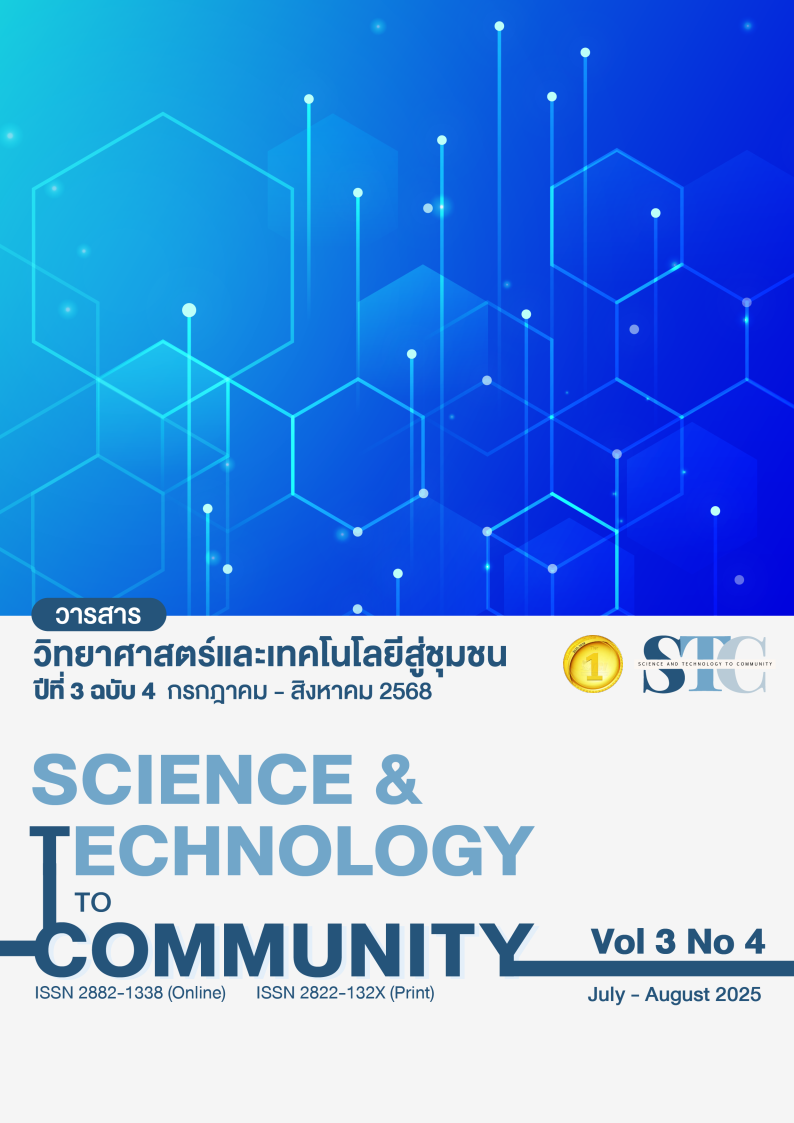การศึกษาลักษณะทางกายภาพ-เคมี และจุลินทรีย์จากน้ำหมักมะม่วงน้ำดอกไม้สีทองสุก
DOI:
https://doi.org/10.57260/stc.2025.1068คำสำคัญ:
มะม่วงน้ำดอกไม้สีทองสุก , น้ำหมักบทคัดย่อ
การทดลองนี้มีวัตถุประสงค์เพื่อศึกษาน้ำหมักจากมะม่วงน้ำดอกไม้สีทองสุก เพื่อนำใปใช้ประโยชน์เป็นอาหารเสริมทางด้านปศุสัตว์ โดยวางแผนการทดลองแบบสุ่มสมบูรณ์ (Completely randomized design: CRD) แบ่งออกเป็น 5 กลุ่มการทดลองๆ ละ 2 ซ้ำ ได้แก่ น้ำหมักมะม่วงน้ำดอกไม้สีทองสุก วันที่ 0 วัน (กลุ่มการทดลองที่ 1) น้ำหมักมะม่วงน้ำดอกไม้สีทองสุก วันที่ 7 วัน (กลุ่มการทดลองที่ 2) น้ำหมักมะม่วงน้ำดอกไม้สีทองสุก วันที่ 14 วัน (กลุ่มการทดลองที่ 3) น้ำหมักมะม่วงน้ำดอกไม้สีทองสุก วันที่ 21 วัน (กลุ่มการทดลองที่ 4) และ น้ำหมักมะม่วงน้ำดอกไม้สีทองสุก วันที่ 28 วัน (กลุ่มการทดลองที่ 5) พบว่า ปริมาณกรดแลคติค, ความเป็นกรด-ด่าง, ปริมาณเบต้า-แคโรทีน และค่าสีของแต่ละกลุ่มการทดลองมีความแตกต่างกันอย่างมีนัยสำคัญทางสถิติ (P<0.05) โดยน้ำหมักจากมะม่วงน้ำดอกไม้สีทองสุกที่ระยะเวลาการหมักที่ 7-28 วัน มีปริมาณกรดแลคติก จุลินทรีย์ทั้งหมด และแลคติกแอซิดแบคทีเรียเพิ่มขึ้น ส่วนปริมาณเบต้า-แคโรทีน และ Bacillus spp. มีปริมาณสูงที่สุดในวันที่ 7 และลดปริมาณลงตามอายุการหมัก
Downloads
เอกสารอ้างอิง
American Public Health Association (APHA). (2015). Compendium of methods for the microbiological examination of foods. (5th ed.). American Public Health Association.
Bhatt, P. C., Ahmad, M., & Panda, B. P. (2013). Enhanced bioaccumulation of astaxanthin in Phaffia rhodozyma by utilising low-cost agro products as fermentation substrate. Biocatalysis and Agricultural Biotechnology, 2(1), 58–63. Retrieved from https://doi.org/10.1016/j.bcab.2012.11.002 DOI: https://doi.org/10.1016/j.bcab.2012.11.002
Bourdichon, F., Casaregola, S., Farrokh, C., Frisvad, J. C., Gerds, M. L., Hammes, W. P., Harnett, J., Huys, G., Laulund, S., & Ouwehand, A. (2012). Food fermentations: Microorganisms with technological beneficial use. International Journal of Food Microbiology, 154(3), 87–97. Retrieved from https://doi.org/10.1016/j.ijfoodmicro.2011.12.030 DOI: https://doi.org/10.1016/j.ijfoodmicro.2011.12.030
Brossaud, J., Pallet, V., & Corcuff, J. B. (2017). Vitamin A, endocrine tissues, and hormones: Interactions and cross-talk. Endocrine Connections, 6, R121–R130. Retrieved from https://doi.org/10.1530/EC-17-0101 DOI: https://doi.org/10.1530/EC-17-0101
Buchanan, R. E., & Gibbons, N. E. (Eds.). (1986). Bergey’s manual of systematic bacteriology: Volume 2. Williams & Wilkins.
Castañeda-Ovando, A., Pacheco-Hernández, M. d. L., Páez-Hernández, M. E., Rodríguez, J. A., & Galán-Vidal, C. A. (2009). Chemical studies of anthocyanins: A review. Food Chemistry, 113(4), 859–871. Retrieved from https://doi.org/10.1016/j.foodchem.2008.09.001 DOI: https://doi.org/10.1016/j.foodchem.2008.09.001
Cele, N. P., Akinola, S. A., Manhivi, V. E., Shoko, T., Remize, F., & Sivakumar, D. (2022). Influence of lactic acid bacterium strains on changes in quality, functional compounds and volatile compounds of mango juice from different cultivars during fermentation. Foods, 11(5), 682. Retrieved from https://doi.org/10.3390/foods11050682 DOI: https://doi.org/10.3390/foods11050682
Chen, H.-H., Wu, J.-X., Huang, R., Dai, J.-L., Liang, M.-H., & Jiang, J. (2024). Enhancing astaxanthin accumulation through the expression of the plant-derived astaxanthin biosynthetic pathway in Dunaliella salina. Plant Physiology and Biochemistry, 211, 108697. Retrieved from https://doi.org/10.1016/j.plaphy.2024.108697 DOI: https://doi.org/10.1016/j.plaphy.2024.108697
Dewi, G. A. M. K., Umiarti, A. T., & Wirapartha, M. (2021). Impact of fermented dragon fruit peel (Hylocereus sp.) juice in drinking water on the performance and quality of Japanese quail eggs. In First Asian PGPR Indonesian Chapter International e-Conference 2021, Volume 2022 (pp. 240–250). Retrieved from https://doi.org/10.18502/kls.v7i3.11127 DOI: https://doi.org/10.18502/kls.v7i3.11127
Dhillon, H. S., Gill, M. S., Kocher, G. S., Panwar, H., & Arora, M. (2021). Preparation of Lactobacillus acidophilus-enriched probiotic mango juice. Journal of Environmental Biology, 42, 371-378. Retrieved from https://www.jeb.co.in/journal_issues/202103_mar21_spl/paper_06.pdf
Escudero-López, B., Cerrillo, I., Gil-Izquierdo, Á., Hornero-Méndez, D., Herrero-Martín, G., & Berná, G. (2016). Effect of thermal processing on the profile of bioactive compounds and antioxidant capacity of fermented orange juice. International Journal Food Research International, 67(7), 779–788. Retrieved from https://doi.org/10.1080/09637486.2016.1204428 DOI: https://doi.org/10.1080/09637486.2016.1204428
Gänzle, M. G. (2015). Lactic metabolism revisited: Metabolism of lactic acid bacteria in food fermentations and food spoilage. Current Opinion in Food Science, 2, 106–117. Retrieved from https://doi.org/10.7939/r3-y86z-se75 DOI: https://doi.org/10.1016/j.cofs.2015.03.001
Gong, Y., Wang, Q., Ma, S., Ma, Y., Meng, Q., Zhang, Z., & Shi, J. (2019). Short-time water immersion inhibits browning of fresh-cut potato by enhancing antioxidant capability and tyrosine scavenging. Journal of Food Process and Preservation, 43, e14168. Retrieved from https://doi.org/10.1111/jfpp.14168 DOI: https://doi.org/10.1111/jfpp.14168
Jin, X., Chen, W. W., Chen, H., Chen, W. W., & Zhong, Q. (2019). Combination of Lactobacillus plantarum and Saccharomyces cerevisiae DV10 as starter culture to produce mango slurry: Microbiological, chemical parameters and antioxidant activity. Molecules, 24(23), 4349. Retrieved from https://doi.org/10.3390/molecules24234349 DOI: https://doi.org/10.3390/molecules24234349
Jompuk, C. (2012). Statistics: Experimental design and Data Analysis in Plant Research with “R”. (2nded.). Kasetsart University Press, Bangkok.
Kang, H. K., Kang, H. R., Lee, Y. S., & Song, H. S. (2020). Characteristics of organic acid contents and fermentation solution of Prunus mume in South Korea. Korean Journal of Polar Research, 33(3), 194–199. Retrieved from https://doi.org/10.7732/kjpr.2020.33.3.194
Kapoor, L., Simkin, A. J., Priya Doss, C. G., & Siva, R. (2022). Fruit ripening: Dynamics and integrated analysis of carotenoids and anthocyanins. BioMed Central Plant Biology, 22(27). Retrieved from https://doi.org/10.1186/s12870-021-03411-w DOI: https://doi.org/10.1186/s12870-021-03411-w
Khanunthong. W., & Thammnamuang. T. (2007). Changes in Bacteria During the Fermentation Process of Bio-extracts and the Effect of Bio-extracts on the Inhibition of Plant Pathogenic Bacteria. Journal of Science Progress in the World, 7(2), 63–70. Retrieved from http://sci.bsru.ac.th/sciweb/e-magazine/7-2/chapter-9.pdf
Kim, D.-H., Bae, J. M., Park, J. J., Choi, J. H., Ku, K. H., & Lim, J.-H. (2016). Effect of 1-methylcyclopropene and ethylene-absorbent treatments on quality changes of Prunus mume fruit during storage. Korean Journal of Food Preservation, 23(4), 479–487. Retrieved from https://doi.org/10.11002/kjfp.2016.23.4.479 DOI: https://doi.org/10.11002/kjfp.2016.23.4.479
Kozaki, M., T. Uchimura, & S, Okada. (1992). Experimental Manual of Lactic acid bacteria. Asakurashoten. Tokyo, Japan. Retrieved from https://www.scirp.org/reference/referencespapers?referenceid=855440
Laophongphit, A., Wichiansri, S., Siripornadulsil, S., & Siripornadulsil, W. (2024). Enhancing the nutritional value and functional properties of mango pulp via lactic acid bacteria fermentation. Food Science and Technology, 197(1), 115878. Retrieved from https://doi.org/10.1016/j.lwt.2024.115878 DOI: https://doi.org/10.1016/j.lwt.2024.115878
Mandha, J., Shumoy, H., Devaere, J., Schouteten, J. J., Gellynck, X., De Winne, A., Matemu, A. O., & Raes, K. (2022). Effect of lactic acid fermentation on volatile compounds and sensory characteristics of mango (Mangifera indica) juices. Foods, 11(3), 383. Retrieved from https://doi.org/10.3390/foods11030383 DOI: https://doi.org/10.3390/foods11030383
Marco, M. L., Heeney, D., Binda, S., Cifelli, C. J., Cotter, P. d., Foligne, B., Ganzle, M., Kort, R., Pasin, G., Pihlanto, A., Smid, E. J. & Hutkins, R. (2017). Health benefits of fermented foods: Microbiota and beyond. Current Opinion in Biotechnology, 44, 94–102. Retrieved from https://doi.org/10.1016/j.copbio.2016.11.010 DOI: https://doi.org/10.1016/j.copbio.2016.11.010
Milani, A., Basirnejad, M., Shahbazi, S., & Bolhassani, A. (2017). Carotenoids: Biochemistry, pharmacology, and treatment. British Journal of Pharmacology, 174(11), 1290–1324. Retrieved from https://doi.org/10.1111/bph.13625 DOI: https://doi.org/10.1111/bph.13625
Nelson, D. L., & Cox, M. M. (2017). Lehninger principles of biochemistry. (7th ed.). W.H. Freeman and Sapling Learning.
Ramalingam, S., Ko, K. Y., Lee, J. S., Bahuguna, A., & Kim, M. (2022). Effects of the fruit maturity, processing method, and fermentation time on the physicochemical, functional, and microbial properties of Prunus mume (maesil) sugar syrup during a 1-year fermentation period. Food Research International, 159(1), 113174. Retrieved from https://doi.org/10.1016/j.lwt.2022.113174 DOI: https://doi.org/10.1016/j.lwt.2022.113174
R Core Team. (2023). R: A Language and Environment for Statistical Computing_. R Foundation for Statistical Computing. Vienna, Austria.
Saenphoom P., Chimtong S., Sila-on D., Aemaot K., & Khloiklap N. (2021). Study of fermented juice from sugar palm peel. Khon Kaen Agriculture Journal Suppl, 49(2), 348-353. Retrieved from https://ag2.kku.ac.th/kaj/PDF.cfm?filename=47ID%20228.pdf&id=4572&keeptrack=0
Shalaev, E. Y., Lu, Q., Shalaeva, M., & Zografi, G. (2000). Acid-catalyzed inversion of sucrose in the amorphous state at very low levels of residual water. Pharmaceutical Research, 17(3), 366–370. Retrieved from https://doi.org/10.1023/a:1007517526245 DOI: https://doi.org/10.1023/A:1007517526245
Tamang, J. P., & Fleet, G. H. (2009). Yeasts diversity in fermented foods and beverages. FEMS Yeast Research, 9(7), 1083–1094. Retrieved from https://link.springer.com/chapter/10.1007/978-1-4020-8292-4_9 DOI: https://doi.org/10.1007/978-1-4020-8292-4_9
Thaworncharoen D., Kasemsub P., Suvitavas K., Thanongchit K., Phengchang P., & Chumphukham J. (2024). Evaluation of antioxidant content in the flesh and peel of ripe mango (Mangifera indica). Journal of Agricultural Science and Management, 7(1), 22–29. Retrieved from https://li02.tci-thaijo.org/index.php/JASM/article/view/438
Ward, O. P., & Singh, A. (2017). Principles and applications of fermentation technology. John Wiley & Sons. Retrieved from https://onlinelibrary.wiley.com/doi/book/10.1002/9781119460381
ดาวน์โหลด
เผยแพร่แล้ว
รูปแบบการอ้างอิง
ฉบับ
ประเภทบทความ
สัญญาอนุญาต
ลิขสิทธิ์ (c) 2025 วารสารวิทยาศาสตร์และเทคโนโลยีสู่ชุมชน

อนุญาตภายใต้เงื่อนไข Creative Commons Attribution-NonCommercial-NoDerivatives 4.0 International License.
1. บทความ ข้อมูล เนื้อหา รูปภาพฯลฯ ที่ได้รับการตีพิมพ์ใน “วารสารวิทยาศาสตร์และเทคโนโลยีสู่ชุมชน” ถือเป็นลิขสิทธิ์ของวารสารวิทยาศาสตร์และเทคโนโลยีสู่ชุมชน มหาวิทยาลัยราชภัฏเชียงใหม่ หากบุคคลหรือหน่วยงานใดต้องการนำทั้งหมดหรือส่วนหนึ่งส่วนใดไปเผยแพร่ต่อหรือกระทำการใดๆ จะต้องได้รับอนุญาตเป็นลายลักษณ์อักษรจาก วารสารวิทยาศาสตร์และเทคโนโลยีสู่ชุมชน มหาวิทยาลัยราชภัฏเชียงใหม่
2. เนื้อหาบทความที่ปรากฏในวารสารเป็นความรับผิดชอบของผู้เขียนบทความโดยตรง ซึ่งกองบรรณาธิการวารสารไม่จำเป็นต้องเห็นด้วยหรือร่วมรับผิดชอบใดๆ














